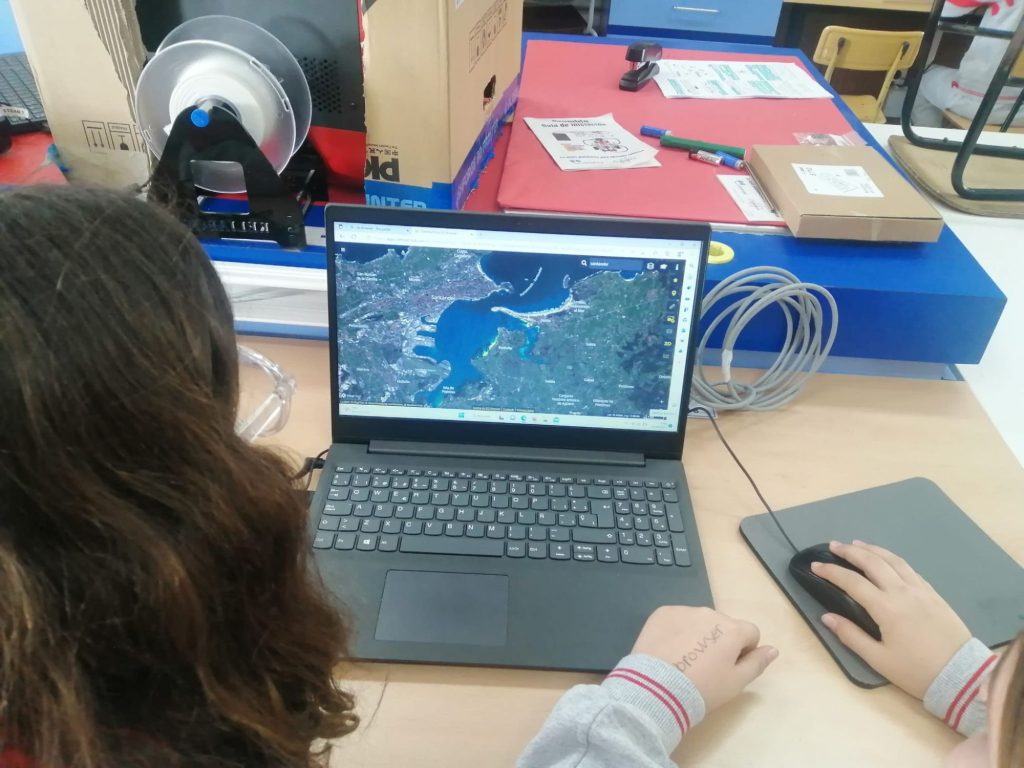Climate Detectives Projects 2022-2023
Project title: Santander Bay and its ecosystem Let’s investigate!
Team: Los investigadores de la SAFA
Colegio Sagrada Familia Camargo Spain 10 Student’s age: 10-11 years old
Can climate change affect the waters and ecosystem of Santander Bay?
¿Puede el cambio climático afectar a las aguas y el ecosistema de la Bahía de Santander?

Interested in a context close to where we live, we have carried out a scientific investigation into the possible relationship between climate change in our city of Santander and possible variations in the waters and ecosystem of our bay. The first thing we did was to analyse information on both human and natural factors that can affect the waters of this ecosystem.
Secondly, we focused on the detailed analysis of temperatures and rainfall in the city of Santander, carrying out a cooperative work reflecting all these data in a spreadsheet document that we shared. Afterwards, we generated graphs with the intention of visualising the evolution of these changes over time, specifically, on a monthly basis from 1997 to 2021. We then summarised these data in a table reflecting the most significant changes found.
The next step was to look for a relationship between them and the waters of our bay, with the result being somewhat inconclusive due to difficulties encountered with the sources of information consulted.
To conclude this brief summary, we would like to point out that the bibliographic and database sources used were the following:
– AEMET.
– METEOCANTABRIA. AUGUSTO GONZÁLEZ LINARES BUOY.
– PORTS OF THE STATE.
– IPCC- WGI-INTERACTIVE ATLAS.
– ENVIRONMENTAL SUSTAINABILITY REPORT FOR THE INFRASTRUCTURE MASTER PLAN OF THE PORT OF SANTANDER. IH CANTABRIA
– EO.BROWSER.
In relation to these sources, we would also like to point out that we have been able to count on the personal resource of some of the families in the class, providing us with their scientific perspective on the subject we have been working on. These interventions have been very enriching for us, as the people who came to our centre used a vocabulary that was closer to our context, and were able to better understand and interpret all the data we were able to collect.
Interesados en un contexto cercano a la localidad donde vivimos, hemos llevado a cabo una investigación con carácter científico, respecto a la posible relación entre el cambio climático en nuestra ciudad de Santander y las posibles variaciones en las aguas y el ecosistema de nuestra bahía. Lo primero que hicimos, fue analizar información sobre los factores tanto humanos como naturales que pueden afectar a las aguas de este ecosistema.
En segundo lugar, nos centramos en el análisis pormenorizado de temperaturas y precipitaciones de la ciudad de Santander, realizando un trabajo cooperativo reflejando todos estos datos en un documento de Hoja de Cálculo que compartimos. Después, generamos unas gráficas con la intención de visualizar la evolución de estos cambios con el paso del tiempo, concretamente, de forma mensual desde el año 1997 hasta el año 2021. Resumimos, posteriormente estos datos en una tabla en la cual se reflejan los cambios encontrados más significativos.
El siguiente paso fue buscar una relación entre ellos y las aguas de nuestra bahía, siendo como resultado algo no concluyente debido a dificultades encontradas con las fuentes de información consultadas.
Para concluir este breve resumen, quisiéramos apuntar que las fuentes bibliográficas, así como de base de datos utilizadas, han sido las siguientes:
– AEMET.
– METEOCANTABRIA. BOYA DE AUGUSTO GONZÁLEZ LINARES.
– PUERTOS DEL ESTADO.
– IPCC- WGI-INTERACTIVE ATLAS.
– INFORME DE SOSTENIBILIDAD AMBIENTAL PARA EL PLAN DIRECTOR DE INFRAESTRUCTURAS DEL PUERTO DE SANTANDER. IH CANTABRIA
– EO.BROWSER.
A colación de estas fuentes comentadas, también nos gustaría indicar que hemos podido contar con el recurso personal de algunas familias de la clase, aportándonos su perspectiva científica sobre el tema trabajado. Estas intervenciones nos han resultado muy enriquecedoras, puesto que las personas que acudieron a nuestro centro utilizaron un vocabulario más cercano a nuestro contexto, pudiendo entender e interpretar mejor todos aquellos datos que hemos podido recopilar.

Santander Bay is a complex and dynamic ecosystem that is influenced by a variety of both natural and human factors. Natural factors include water temperature, salinity, the presence of nutrients, water circulation and tides. All of these factors are important for the maintenance of ecosystem health and can be monitored through the use of data. However, in the case of Santander Bay, we have found a lack of important data such as salinity and water temperature. In addition, the information we have been able to access has been difficult to interpret due to formatting problems. This lack of accurate and accessible data has limited our analysis of the bay and made it difficult to draw clear conclusions.
Tools such as EO Browser have helped us to obtain more precise data, related for example to chlorophyll, by accessing satellite images, although we have also taken into account certain limitations in their use (degree of cloudiness, presence of sediments and turbidity of the water…) Nevertheless, one of our greatest concerns, once this interpretation of results has been made, is to continue in this process of searching and reflecting on the bay of our town.
La bahía de Santander es un ecosistema complejo y dinámico que está influenciado por una variedad de factores tanto naturales como humanos. En cuanto a los factores naturales, se encuentran la temperatura del agua, la salinidad, la presencia de nutrientes, la circulación del agua y las mareas. Todos estos factores son importantes para el mantenimiento de la salud del ecosistema y pueden ser monitoreados a través del uso de datos. Sin embargo, en el caso de la bahía de Santander, hemos encontrado una carestía de datos importantes como la salinidad y la temperatura del agua. Además, la información a la que hemos podido acceder ha sido difícil de interpretar debido a problemas de formato. Esta falta de datos precisos y accesibles nos ha limitado el análisis de la bahía y dificultado la extracción de conclusiones evidentes.
Herramientas como EO Browser nos han servido para obtener algún dato más preciso, relacionado por ejemplo con la clorofila, accediendo a imágenes de satélite, aunque también hemos tenido en cuenta ciertas limitaciones en su uso (grado de nubosidad, presencia de sedimentos y turbidez del agua…) No obstante, uno de nuestras mayores inquietudes, una vez hecho esta interpretación de resultados, es continuar en este proceso de búsqueda y de reflexión acerca de la bahía de nuestra localidad.

In order to improve the current situation of pollution that directly affects the biological environment of the Bay of Santander, we consider it important to take into account a series of actions to benefit this coastal geographical feature of our town. The measures are:
– Environmental monitoring and control programmes.
– Information campaigns to raise awareness of the importance of our seas.
– Control of polluting discharges in strict compliance with the regulations.
– Making use of the most innovative technologies for water sanitation.
– Improve access to data for citizens, because we have encountered many difficulties in finding this data.
Para poder favorecer la situación actual de contaminación que afecta directamente al entorno bilógico de la bahía de Santander, consideramos importante tener en cuenta una serie de actuaciones con las que conseguir beneficiar este accidente geográfico costero de nuestra localidad. Las medidas son:
– Programas de vigilancia y control ambiental.
– Campañas informativas de concienciación de la importancia de nuestros mares.
– Control de vertidos contaminantes cumpliendo rigurosamente la normativa.
– Hacer uso de las tecnologías más innovadoras para el saneamiento de las aguas.
– Mejorar el acceso a datos a los ciudadanos, porque hemos encontrado bastantes dificultades a la hora de encontrar esos datos.
This project was automatically translated into English.
Projects are created by the teams and they take the full responsibility of the shared data.
← All projects





